ABA plc: Financial Analysis of Electric Cycle and Scooter Projects
VerifiedAdded on 2022/12/29
|8
|1453
|83
Report
AI Summary
This report provides a financial analysis of two potential investment projects for ABA plc: an electric cycle project and an electric scooter project. The analysis includes the calculation of Net Present Value (NPV) and payback periods for each project to assess their financial viability. The report determines that the electric cycle project has a higher NPV, while the electric scooter project has a slightly shorter payback period. Furthermore, it elaborates on both financial factors, such as revenues and expenditures, and non-financial factors, such as management expertise, that play a crucial role in the investment decision-making process. The conclusion highlights the importance of considering both financial metrics and other relevant factors when evaluating investment opportunities. References to relevant academic sources are also included.

Business
Paraphrase This Document
Need a fresh take? Get an instant paraphrase of this document with our AI Paraphraser
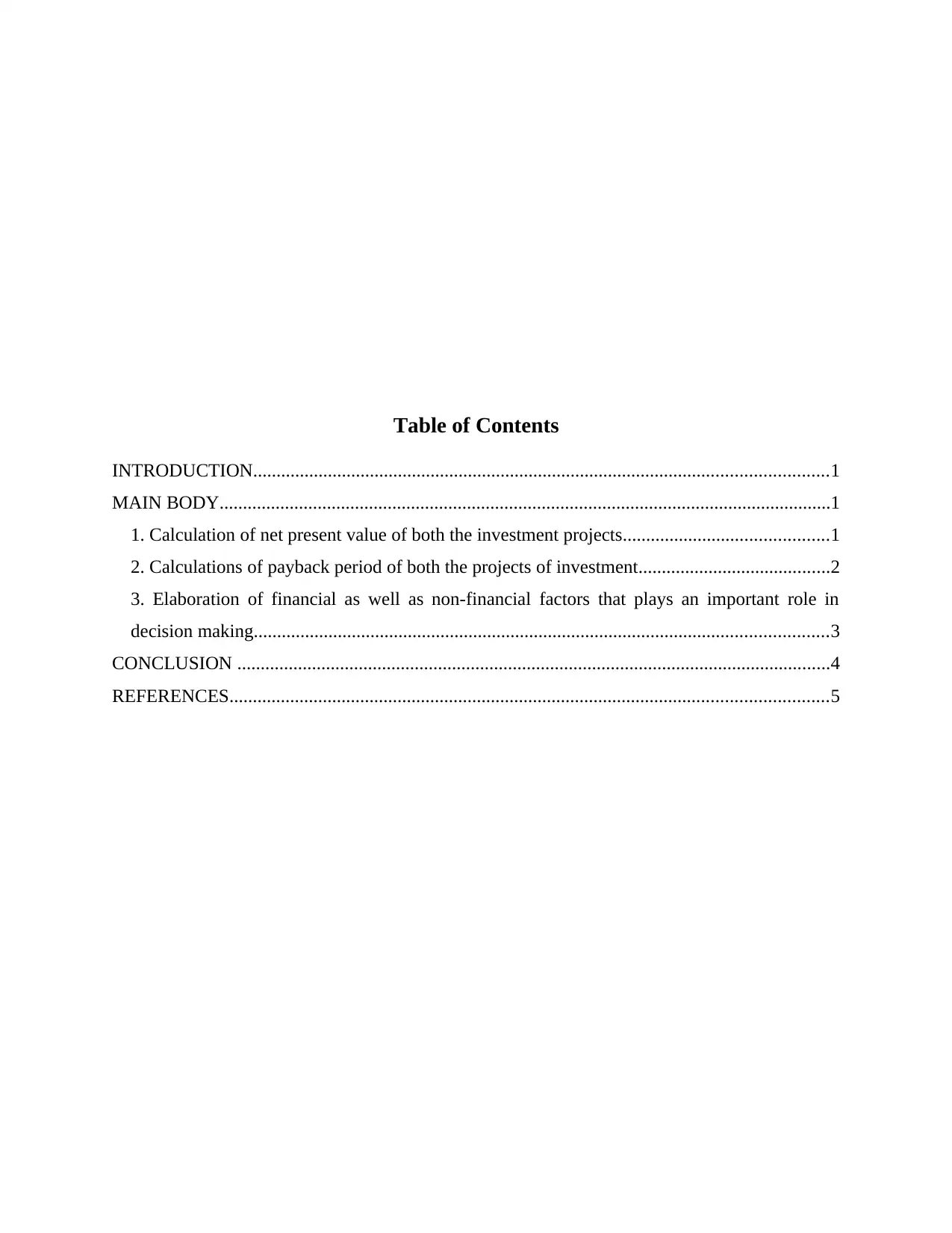
Table of Contents
INTRODUCTION...........................................................................................................................1
MAIN BODY...................................................................................................................................1
1. Calculation of net present value of both the investment projects............................................1
2. Calculations of payback period of both the projects of investment.........................................2
3. Elaboration of financial as well as non-financial factors that plays an important role in
decision making...........................................................................................................................3
CONCLUSION ...............................................................................................................................4
REFERENCES................................................................................................................................5
INTRODUCTION...........................................................................................................................1
MAIN BODY...................................................................................................................................1
1. Calculation of net present value of both the investment projects............................................1
2. Calculations of payback period of both the projects of investment.........................................2
3. Elaboration of financial as well as non-financial factors that plays an important role in
decision making...........................................................................................................................3
CONCLUSION ...............................................................................................................................4
REFERENCES................................................................................................................................5

⊘ This is a preview!⊘
Do you want full access?
Subscribe today to unlock all pages.

Trusted by 1+ million students worldwide
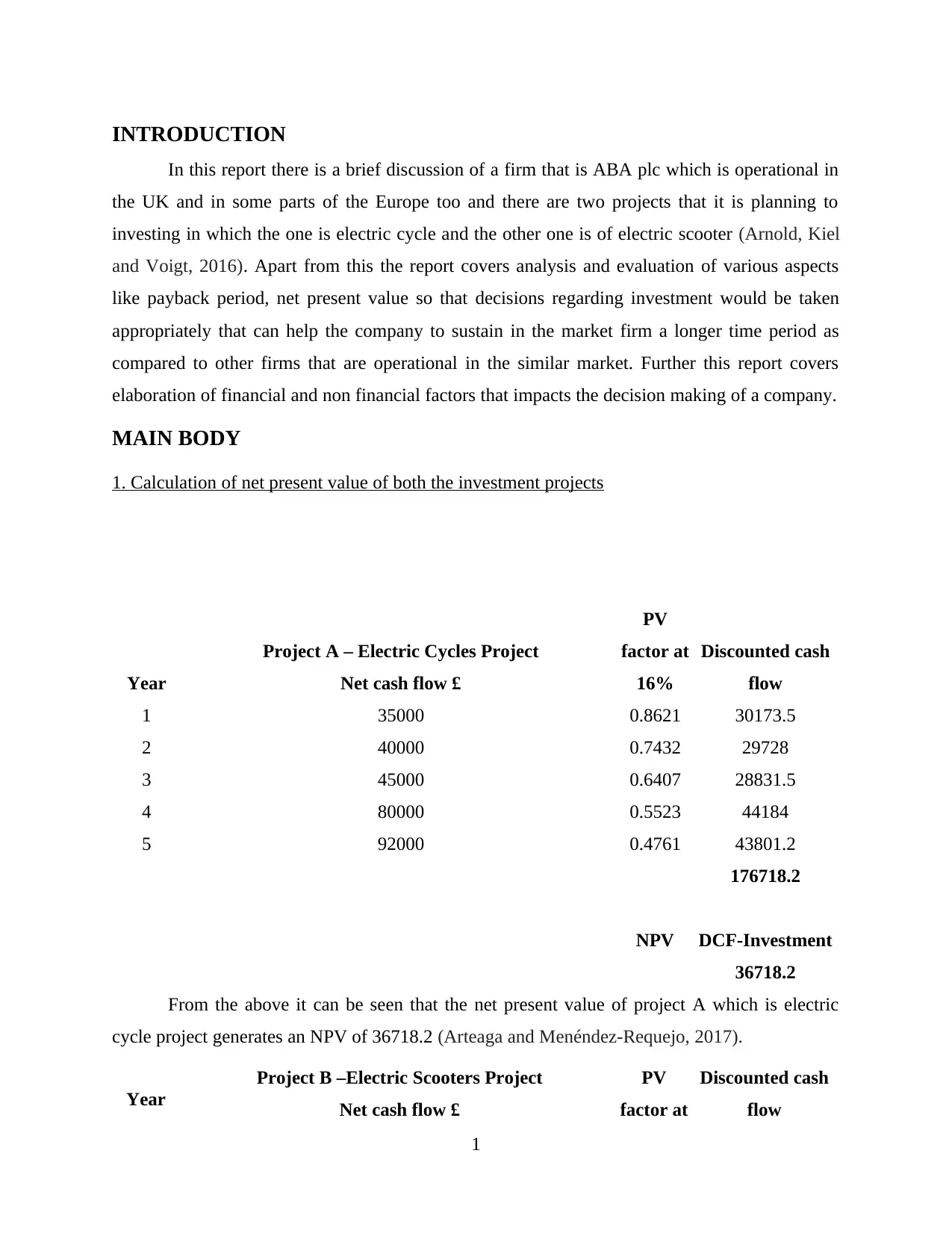
INTRODUCTION
In this report there is a brief discussion of a firm that is ABA plc which is operational in
the UK and in some parts of the Europe too and there are two projects that it is planning to
investing in which the one is electric cycle and the other one is of electric scooter (Arnold, Kiel
and Voigt, 2016). Apart from this the report covers analysis and evaluation of various aspects
like payback period, net present value so that decisions regarding investment would be taken
appropriately that can help the company to sustain in the market firm a longer time period as
compared to other firms that are operational in the similar market. Further this report covers
elaboration of financial and non financial factors that impacts the decision making of a company.
MAIN BODY
1. Calculation of net present value of both the investment projects
Year
Project A – Electric Cycles Project
Net cash flow £
PV
factor at
16%
Discounted cash
flow
1 35000 0.8621 30173.5
2 40000 0.7432 29728
3 45000 0.6407 28831.5
4 80000 0.5523 44184
5 92000 0.4761 43801.2
176718.2
NPV DCF-Investment
36718.2
From the above it can be seen that the net present value of project A which is electric
cycle project generates an NPV of 36718.2 (Arteaga and Menéndez-Requejo, 2017).
Year
Project B –Electric Scooters Project
Net cash flow £
PV
factor at
Discounted cash
flow
1
In this report there is a brief discussion of a firm that is ABA plc which is operational in
the UK and in some parts of the Europe too and there are two projects that it is planning to
investing in which the one is electric cycle and the other one is of electric scooter (Arnold, Kiel
and Voigt, 2016). Apart from this the report covers analysis and evaluation of various aspects
like payback period, net present value so that decisions regarding investment would be taken
appropriately that can help the company to sustain in the market firm a longer time period as
compared to other firms that are operational in the similar market. Further this report covers
elaboration of financial and non financial factors that impacts the decision making of a company.
MAIN BODY
1. Calculation of net present value of both the investment projects
Year
Project A – Electric Cycles Project
Net cash flow £
PV
factor at
16%
Discounted cash
flow
1 35000 0.8621 30173.5
2 40000 0.7432 29728
3 45000 0.6407 28831.5
4 80000 0.5523 44184
5 92000 0.4761 43801.2
176718.2
NPV DCF-Investment
36718.2
From the above it can be seen that the net present value of project A which is electric
cycle project generates an NPV of 36718.2 (Arteaga and Menéndez-Requejo, 2017).
Year
Project B –Electric Scooters Project
Net cash flow £
PV
factor at
Discounted cash
flow
1
Paraphrase This Document
Need a fresh take? Get an instant paraphrase of this document with our AI Paraphraser
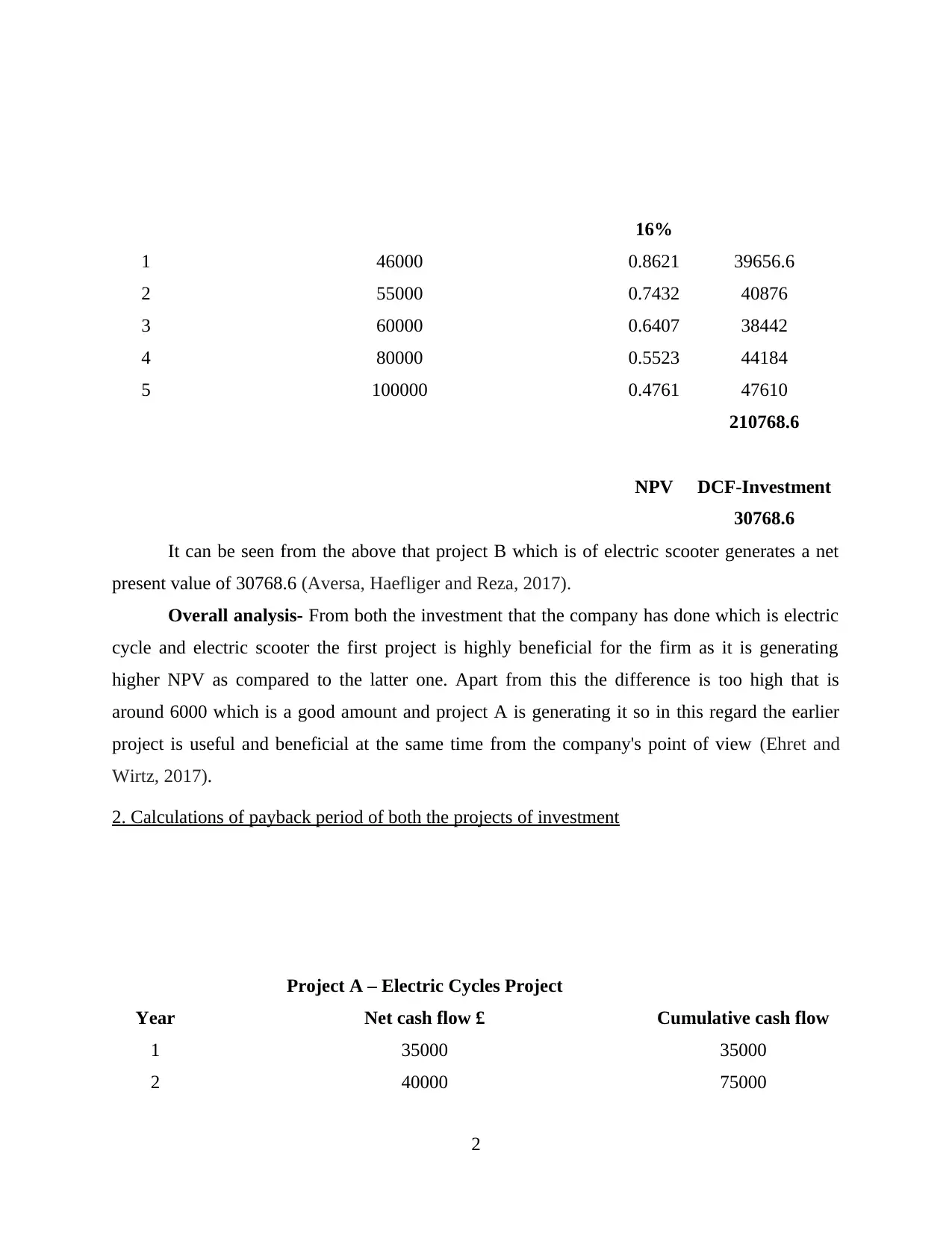
16%
1 46000 0.8621 39656.6
2 55000 0.7432 40876
3 60000 0.6407 38442
4 80000 0.5523 44184
5 100000 0.4761 47610
210768.6
NPV DCF-Investment
30768.6
It can be seen from the above that project B which is of electric scooter generates a net
present value of 30768.6 (Aversa, Haefliger and Reza, 2017).
Overall analysis- From both the investment that the company has done which is electric
cycle and electric scooter the first project is highly beneficial for the firm as it is generating
higher NPV as compared to the latter one. Apart from this the difference is too high that is
around 6000 which is a good amount and project A is generating it so in this regard the earlier
project is useful and beneficial at the same time from the company's point of view (Ehret and
Wirtz, 2017).
2. Calculations of payback period of both the projects of investment
Year
Project A – Electric Cycles Project
Net cash flow £ Cumulative cash flow
1 35000 35000
2 40000 75000
2
1 46000 0.8621 39656.6
2 55000 0.7432 40876
3 60000 0.6407 38442
4 80000 0.5523 44184
5 100000 0.4761 47610
210768.6
NPV DCF-Investment
30768.6
It can be seen from the above that project B which is of electric scooter generates a net
present value of 30768.6 (Aversa, Haefliger and Reza, 2017).
Overall analysis- From both the investment that the company has done which is electric
cycle and electric scooter the first project is highly beneficial for the firm as it is generating
higher NPV as compared to the latter one. Apart from this the difference is too high that is
around 6000 which is a good amount and project A is generating it so in this regard the earlier
project is useful and beneficial at the same time from the company's point of view (Ehret and
Wirtz, 2017).
2. Calculations of payback period of both the projects of investment
Year
Project A – Electric Cycles Project
Net cash flow £ Cumulative cash flow
1 35000 35000
2 40000 75000
2
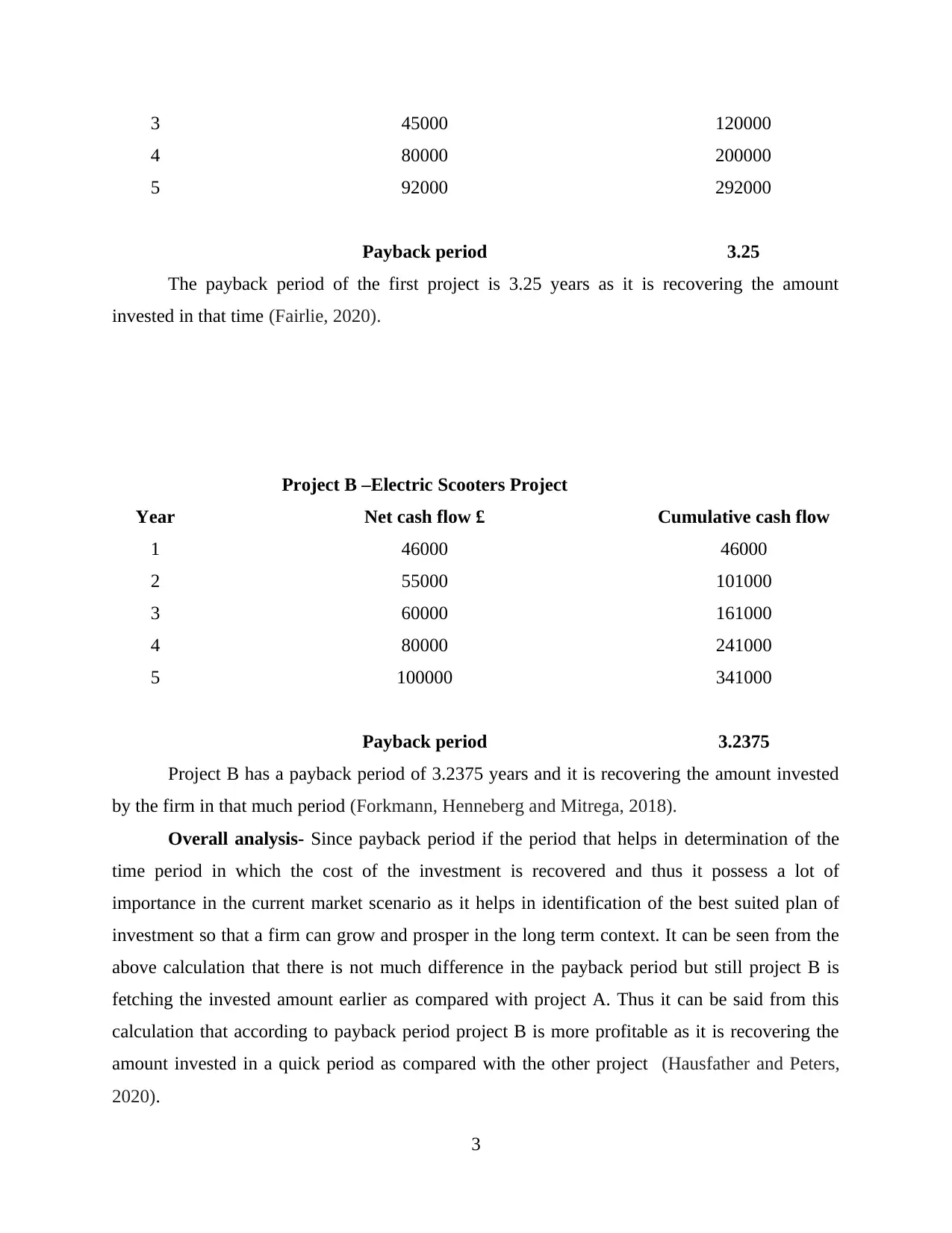
3 45000 120000
4 80000 200000
5 92000 292000
Payback period 3.25
The payback period of the first project is 3.25 years as it is recovering the amount
invested in that time (Fairlie, 2020).
Year
Project B –Electric Scooters Project
Net cash flow £ Cumulative cash flow
1 46000 46000
2 55000 101000
3 60000 161000
4 80000 241000
5 100000 341000
Payback period 3.2375
Project B has a payback period of 3.2375 years and it is recovering the amount invested
by the firm in that much period (Forkmann, Henneberg and Mitrega, 2018).
Overall analysis- Since payback period if the period that helps in determination of the
time period in which the cost of the investment is recovered and thus it possess a lot of
importance in the current market scenario as it helps in identification of the best suited plan of
investment so that a firm can grow and prosper in the long term context. It can be seen from the
above calculation that there is not much difference in the payback period but still project B is
fetching the invested amount earlier as compared with project A. Thus it can be said from this
calculation that according to payback period project B is more profitable as it is recovering the
amount invested in a quick period as compared with the other project (Hausfather and Peters,
2020).
3
4 80000 200000
5 92000 292000
Payback period 3.25
The payback period of the first project is 3.25 years as it is recovering the amount
invested in that time (Fairlie, 2020).
Year
Project B –Electric Scooters Project
Net cash flow £ Cumulative cash flow
1 46000 46000
2 55000 101000
3 60000 161000
4 80000 241000
5 100000 341000
Payback period 3.2375
Project B has a payback period of 3.2375 years and it is recovering the amount invested
by the firm in that much period (Forkmann, Henneberg and Mitrega, 2018).
Overall analysis- Since payback period if the period that helps in determination of the
time period in which the cost of the investment is recovered and thus it possess a lot of
importance in the current market scenario as it helps in identification of the best suited plan of
investment so that a firm can grow and prosper in the long term context. It can be seen from the
above calculation that there is not much difference in the payback period but still project B is
fetching the invested amount earlier as compared with project A. Thus it can be said from this
calculation that according to payback period project B is more profitable as it is recovering the
amount invested in a quick period as compared with the other project (Hausfather and Peters,
2020).
3
⊘ This is a preview!⊘
Do you want full access?
Subscribe today to unlock all pages.

Trusted by 1+ million students worldwide
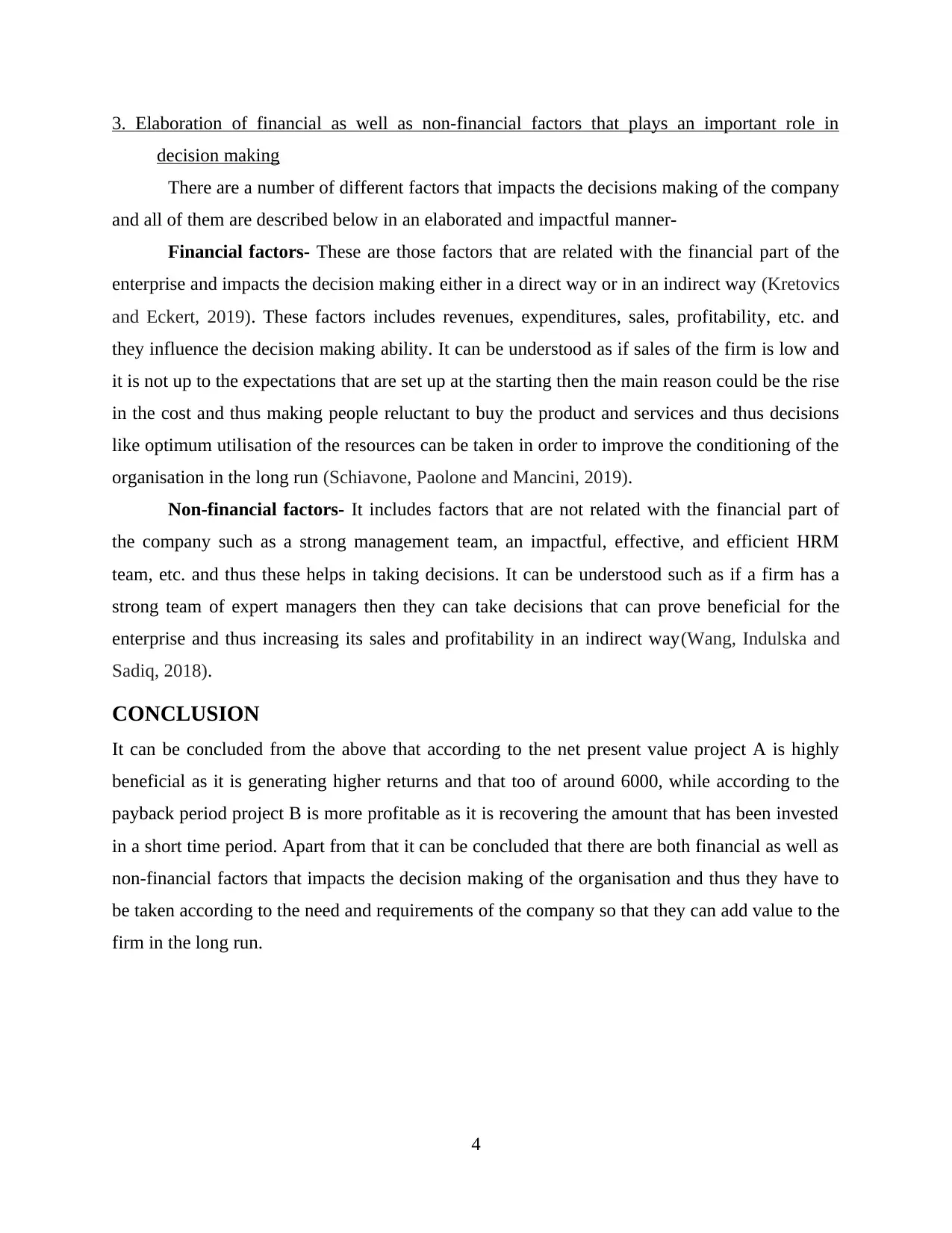
3. Elaboration of financial as well as non-financial factors that plays an important role in
decision making
There are a number of different factors that impacts the decisions making of the company
and all of them are described below in an elaborated and impactful manner-
Financial factors- These are those factors that are related with the financial part of the
enterprise and impacts the decision making either in a direct way or in an indirect way (Kretovics
and Eckert, 2019). These factors includes revenues, expenditures, sales, profitability, etc. and
they influence the decision making ability. It can be understood as if sales of the firm is low and
it is not up to the expectations that are set up at the starting then the main reason could be the rise
in the cost and thus making people reluctant to buy the product and services and thus decisions
like optimum utilisation of the resources can be taken in order to improve the conditioning of the
organisation in the long run (Schiavone, Paolone and Mancini, 2019).
Non-financial factors- It includes factors that are not related with the financial part of
the company such as a strong management team, an impactful, effective, and efficient HRM
team, etc. and thus these helps in taking decisions. It can be understood such as if a firm has a
strong team of expert managers then they can take decisions that can prove beneficial for the
enterprise and thus increasing its sales and profitability in an indirect way(Wang, Indulska and
Sadiq, 2018).
CONCLUSION
It can be concluded from the above that according to the net present value project A is highly
beneficial as it is generating higher returns and that too of around 6000, while according to the
payback period project B is more profitable as it is recovering the amount that has been invested
in a short time period. Apart from that it can be concluded that there are both financial as well as
non-financial factors that impacts the decision making of the organisation and thus they have to
be taken according to the need and requirements of the company so that they can add value to the
firm in the long run.
4
decision making
There are a number of different factors that impacts the decisions making of the company
and all of them are described below in an elaborated and impactful manner-
Financial factors- These are those factors that are related with the financial part of the
enterprise and impacts the decision making either in a direct way or in an indirect way (Kretovics
and Eckert, 2019). These factors includes revenues, expenditures, sales, profitability, etc. and
they influence the decision making ability. It can be understood as if sales of the firm is low and
it is not up to the expectations that are set up at the starting then the main reason could be the rise
in the cost and thus making people reluctant to buy the product and services and thus decisions
like optimum utilisation of the resources can be taken in order to improve the conditioning of the
organisation in the long run (Schiavone, Paolone and Mancini, 2019).
Non-financial factors- It includes factors that are not related with the financial part of
the company such as a strong management team, an impactful, effective, and efficient HRM
team, etc. and thus these helps in taking decisions. It can be understood such as if a firm has a
strong team of expert managers then they can take decisions that can prove beneficial for the
enterprise and thus increasing its sales and profitability in an indirect way(Wang, Indulska and
Sadiq, 2018).
CONCLUSION
It can be concluded from the above that according to the net present value project A is highly
beneficial as it is generating higher returns and that too of around 6000, while according to the
payback period project B is more profitable as it is recovering the amount that has been invested
in a short time period. Apart from that it can be concluded that there are both financial as well as
non-financial factors that impacts the decision making of the organisation and thus they have to
be taken according to the need and requirements of the company so that they can add value to the
firm in the long run.
4
Paraphrase This Document
Need a fresh take? Get an instant paraphrase of this document with our AI Paraphraser
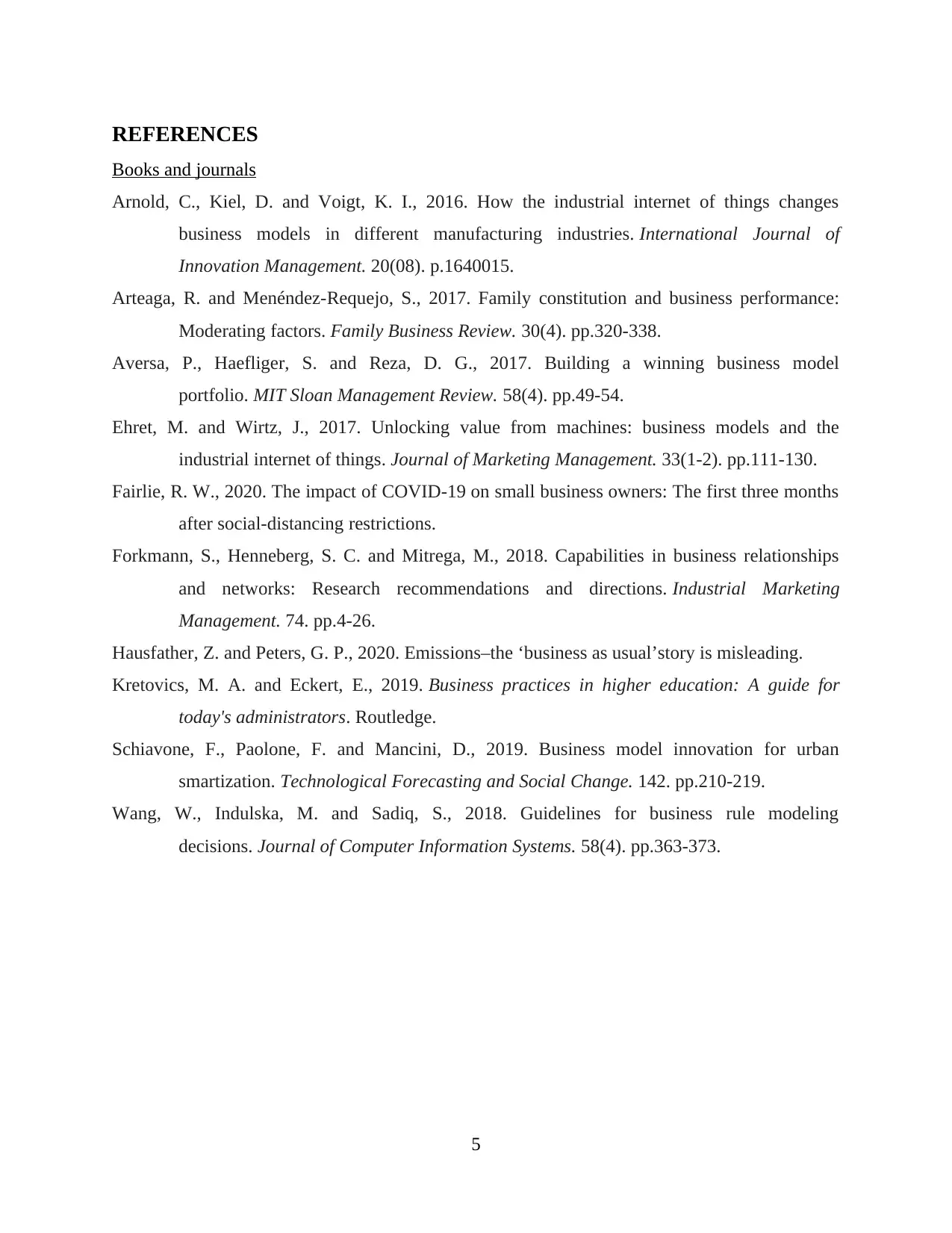
REFERENCES
Books and journals
Arnold, C., Kiel, D. and Voigt, K. I., 2016. How the industrial internet of things changes
business models in different manufacturing industries. International Journal of
Innovation Management. 20(08). p.1640015.
Arteaga, R. and Menéndez-Requejo, S., 2017. Family constitution and business performance:
Moderating factors. Family Business Review. 30(4). pp.320-338.
Aversa, P., Haefliger, S. and Reza, D. G., 2017. Building a winning business model
portfolio. MIT Sloan Management Review. 58(4). pp.49-54.
Ehret, M. and Wirtz, J., 2017. Unlocking value from machines: business models and the
industrial internet of things. Journal of Marketing Management. 33(1-2). pp.111-130.
Fairlie, R. W., 2020. The impact of COVID-19 on small business owners: The first three months
after social-distancing restrictions.
Forkmann, S., Henneberg, S. C. and Mitrega, M., 2018. Capabilities in business relationships
and networks: Research recommendations and directions. Industrial Marketing
Management. 74. pp.4-26.
Hausfather, Z. and Peters, G. P., 2020. Emissions–the ‘business as usual’story is misleading.
Kretovics, M. A. and Eckert, E., 2019. Business practices in higher education: A guide for
today's administrators. Routledge.
Schiavone, F., Paolone, F. and Mancini, D., 2019. Business model innovation for urban
smartization. Technological Forecasting and Social Change. 142. pp.210-219.
Wang, W., Indulska, M. and Sadiq, S., 2018. Guidelines for business rule modeling
decisions. Journal of Computer Information Systems. 58(4). pp.363-373.
5
Books and journals
Arnold, C., Kiel, D. and Voigt, K. I., 2016. How the industrial internet of things changes
business models in different manufacturing industries. International Journal of
Innovation Management. 20(08). p.1640015.
Arteaga, R. and Menéndez-Requejo, S., 2017. Family constitution and business performance:
Moderating factors. Family Business Review. 30(4). pp.320-338.
Aversa, P., Haefliger, S. and Reza, D. G., 2017. Building a winning business model
portfolio. MIT Sloan Management Review. 58(4). pp.49-54.
Ehret, M. and Wirtz, J., 2017. Unlocking value from machines: business models and the
industrial internet of things. Journal of Marketing Management. 33(1-2). pp.111-130.
Fairlie, R. W., 2020. The impact of COVID-19 on small business owners: The first three months
after social-distancing restrictions.
Forkmann, S., Henneberg, S. C. and Mitrega, M., 2018. Capabilities in business relationships
and networks: Research recommendations and directions. Industrial Marketing
Management. 74. pp.4-26.
Hausfather, Z. and Peters, G. P., 2020. Emissions–the ‘business as usual’story is misleading.
Kretovics, M. A. and Eckert, E., 2019. Business practices in higher education: A guide for
today's administrators. Routledge.
Schiavone, F., Paolone, F. and Mancini, D., 2019. Business model innovation for urban
smartization. Technological Forecasting and Social Change. 142. pp.210-219.
Wang, W., Indulska, M. and Sadiq, S., 2018. Guidelines for business rule modeling
decisions. Journal of Computer Information Systems. 58(4). pp.363-373.
5
1 out of 8
Related Documents
Your All-in-One AI-Powered Toolkit for Academic Success.
+13062052269
info@desklib.com
Available 24*7 on WhatsApp / Email
![[object Object]](/_next/static/media/star-bottom.7253800d.svg)
Unlock your academic potential
Copyright © 2020–2025 A2Z Services. All Rights Reserved. Developed and managed by ZUCOL.





